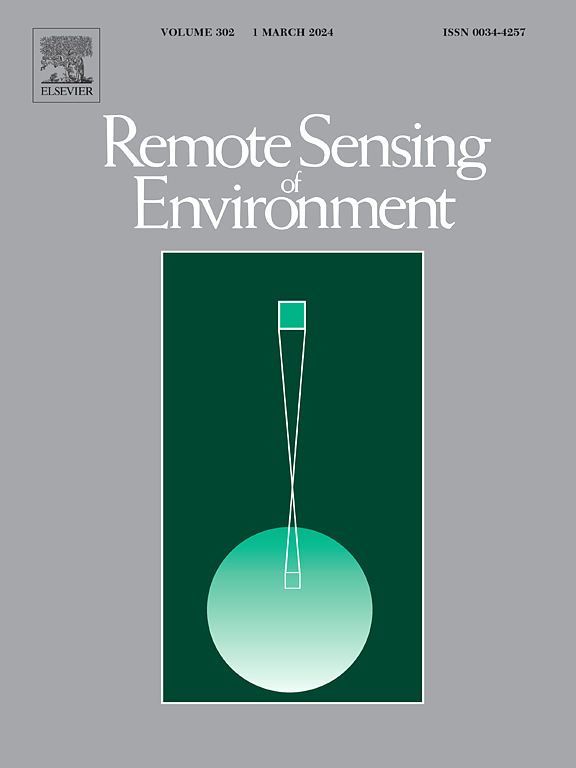基于多时相InSAR时间序列的可解释性关注深度学习滑坡预测方法——以青藏高原新浦滑坡为例
IF 11.1
1区 地球科学
Q1 ENVIRONMENTAL SCIENCES
引用次数: 0
摘要
滑坡变形预测是滑坡预警系统的重要组成部分。虽然传统的岩土原位监测由于其高成本和大区域的空间限制而受到限制,但基于遥感数据的深度学习方法在当代预测研究中越来越普遍,但这往往会产生神秘的“黑匣子”问题。为了解决这个问题,我们通过结合基于注意机制的可解释深度学习和多时相干涉合成孔径雷达(MT-InSAR)技术来改进滑坡位移预测框架。MT-InSAR首先用于从哥白尼Sentinel-1 SAR图像中提取滑坡位移时间序列。然后利用变分模态分解(VMD)将非线性位移时间序列分解为趋势分量、季节分量和噪声分量。应用自回归综合移动平均(ARIMA)模型和双向门控循环单元(BiGRU)分别预测趋势和季节位移。这些预测的输入是通过分析滑坡的影响因素来确定的。以三峡库区新浦滑坡为例,对该方法进行了评价,并与现有模型进行了性能比较。CNN-Attention-BiGRU算法有效捕获了滑坡变形与其触发因素之间的非线性关系,优于传统的深度学习模型(如BiLSTM、BiGRU和CNN-BiGRU),均方根误差(rmse)提高21%-55%,平均绝对误差(MAEs)提高23%-56%。该方法利用深度学习和注意机制,考虑了滑坡变形的基本原理,对预测建模相对重要性较高的因子被解释为每年4 - 8月的集中,能够更有效、更准确地预测研究库区的大规模滑坡运动学。本文章由计算机程序翻译,如有差异,请以英文原文为准。
An interpretable attention-based deep learning method for landslide prediction based on multi-temporal InSAR time series: A case study of Xinpu landslide in the TGRA
The prediction of landslide deformation is crucial for early warning systems. While conventional geotechnical in-situ monitoring is restricted due to its high cost and spatial limitations over large regions, deep learning-based methodologies with remote sensing data have become increasingly prevalent in contemporary predictive research, yet this frequently engenders the enigmatic “black box” issue. To address this, we improve the landslide displacement prediction framework by combining interpretable deep learning based on an attention mechanism and Multi-Temporal Interferometric Synthetic Aperture Radar (MT-InSAR) techniques. MT-InSAR is first used to extract a landslide displacement time series from Copernicus Sentinel-1 SAR images. Then Variational Mode Decomposition (VMD) is employed to separate the nonlinear displacement time series into trend, seasonal, and noise components. The Auto-Regressive Integrated Moving Average (ARIMA) model and Bidirectional Gated Recurrent Unit (BiGRU) are applied to predict trend and seasonal displacements, respectively. The inputs for these predictions are determined by analyzing landslide influencing factors. This study uses the Xinpu landslide in the Three Gorges Reservoir Area of China to evaluate the proposed method and compare its performance with existing models. The CNN-Attention-BiGRU algorithm effectively captures the nonlinear relationship between landslide deformation and its triggering factors, outperforming conventional deep learning models such as BiLSTM, BiGRU, and CNN-BiGRU, achieving improvements in Root Mean Square Errors (RMSEs) by 21%—55% and Mean Absolute Errors (MAEs) by 23%—56%. By applying deep learning with an attention mechanism, our proposed method considers the underlying principles of landslide deformation, and factors with higher relative importance for prediction modeling are interpreted to be concentrated annually between April and August, enabling a more effective and more accurate prediction of large-scale landslide kinematics for the studied reservoir region.
求助全文
通过发布文献求助,成功后即可免费获取论文全文。
去求助
来源期刊

Remote Sensing of Environment
环境科学-成像科学与照相技术
CiteScore
25.10
自引率
8.90%
发文量
455
审稿时长
53 days
期刊介绍:
Remote Sensing of Environment (RSE) serves the Earth observation community by disseminating results on the theory, science, applications, and technology that contribute to advancing the field of remote sensing. With a thoroughly interdisciplinary approach, RSE encompasses terrestrial, oceanic, and atmospheric sensing.
The journal emphasizes biophysical and quantitative approaches to remote sensing at local to global scales, covering a diverse range of applications and techniques.
RSE serves as a vital platform for the exchange of knowledge and advancements in the dynamic field of remote sensing.
 求助内容:
求助内容: 应助结果提醒方式:
应助结果提醒方式:


